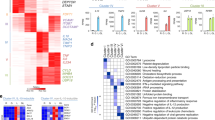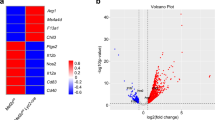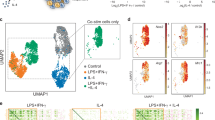Abstract
Stimulation of macrophages with interferon-γ (IFN-γ) and interleukin 4 (IL-4) triggers distinct and opposing activation programs. During mixed infections or cancer, macrophages are often exposed to both cytokines, but how these two programs influence each other remains unclear. We found that IFN-γ and IL-4 mutually inhibited the epigenomic and transcriptional changes induced by each cytokine alone. Computational and functional analyses revealed the genomic bases for gene-specific cross-repression. For instance, while binding motifs for the transcription factors STAT1 and IRF1 were associated with robust and IL-4-resistant responses to IFN-γ, their coexistence with binding sites for auxiliary transcription factors such as AP-1 generated vulnerability to IL-4-mediated inhibition. These data provide a core mechanistic framework for the integration of signals that control macrophage activation in complex environmental conditions.
This is a preview of subscription content, access via your institution
Access options
Access Nature and 54 other Nature Portfolio journals
Get Nature+, our best-value online-access subscription
$29.99 / 30 days
cancel any time
Subscribe to this journal
Receive 12 print issues and online access
$209.00 per year
only $17.42 per issue
Buy this article
- Purchase on Springer Link
- Instant access to full article PDF
Prices may be subject to local taxes which are calculated during checkout







Similar content being viewed by others
Accession codes
References
Glass, C.K. & Natoli, G. Molecular control of activation and priming in macrophages. Nat. Immunol. 17, 26–33 (2016).
Murray, P.J. et al. Macrophage activation and polarization: nomenclature and experimental guidelines. Immunity 41, 14–20 (2014).
Sica, A. & Mantovani, A. Macrophage plasticity and polarization: in vivo veritas. J. Clin. Invest. 122, 787–795 (2012).
Lawrence, T. & Natoli, G. Transcriptional regulation of macrophage polarization: enabling diversity with identity. Nat. Rev. Immunol. 11, 750–761 (2011).
Gordon, S. & Martinez, F.O. Alternative activation of macrophages: mechanism and functions. Immunity 32, 593–604 (2010).
Murray, P.J. & Wynn, T.A. Protective and pathogenic functions of macrophage subsets. Nat. Rev. Immunol. 11, 723–737 (2011).
Ostuni, R. et al. Latent enhancers activated by stimulation in differentiated cells. Cell 152, 157–171 (2013).
Monticelli, S. & Natoli, G. Short-term memory of danger signals and environmental stimuli in immune cells. Nat. Immunol. 14, 777–784 (2013).
Netea, M.G. et al. Trained immunity: A program of innate immune memory in health and disease. Science 352, aaf1098 (2016).
Lavin, Y. et al. Tissue-resident macrophage enhancer landscapes are shaped by the local microenvironment. Cell 159, 1312–1326 (2014).
Xue, J. et al. Transcriptome-based network analysis reveals a spectrum model of human macrophage activation. Immunity 40, 274–288 (2014).
Allen, J.E. & Maizels, R.M. Diversity and dialogue in immunity to helminths. Nat. Rev. Immunol. 11, 375–388 (2011).
Elliott, D.E. & Weinstock, J.V. Helminth-host immunological interactions: prevention and control of immune-mediated diseases. Ann. NY Acad. Sci. 1247, 83–96 (2012).
Osborne, L.C. et al. Virus-helminth coinfection reveals a microbiota-independent mechanism of immunomodulation. Science 345, 578–582 (2014).
Reese, T.A. et al. Helminth infection reactivates latent γ-herpesvirus via cytokine competition at a viral promoter. Science 345, 573–577 (2014).
Salgame, P., Yap, G.S. & Gause, W.C. Effect of helminth-induced immunity on infections with microbial pathogens. Nat. Immunol. 14, 1118–1126 (2013).
Harris, J. et al. T helper 2 cytokines inhibit autophagic control of intracellular Mycobacterium tuberculosis. Immunity 27, 505–517 (2007).
Potian, J.A. et al. Preexisting helminth infection induces inhibition of innate pulmonary anti-tuberculosis defense by engaging the IL-4 receptor pathway. J. Exp. Med. 208, 1863–1874 (2011).
Schleicher, U. et al. TNF-mediated restriction of arginase 1 expression in myeloid cells triggers type 2 NO synthase activity at the site of infection. Cell Rep. 15, 1062–1075 (2016).
Ostuni, R., Kratochvill, F., Murray, P.J. & Natoli, G. Macrophages and cancer: from mechanisms to therapeutic implications. Trends Immunol. 36, 229–239 (2015).
Creyghton, M.P. et al. Histone H3K27ac separates active from poised enhancers and predicts developmental state. Proc. Natl. Acad. Sci. USA 107, 21931–21936 (2010).
Rada-Iglesias, A. et al. A unique chromatin signature uncovers early developmental enhancers in humans. Nature 470, 279–283 (2011).
Kaikkonen, M.U. et al. Remodeling of the enhancer landscape during macrophage activation is coupled to enhancer transcription. Mol. Cell 51, 310–325 (2013).
Ivashkiv, L.B. & Donlin, L.T. Regulation of type I interferon responses. Nat. Rev. Immunol. 14, 36–49 (2014).
Andersson, R. et al. An atlas of active enhancers across human cell types and tissues. Nature 507, 455–461 (2014).
Pello, O.M. et al. Role of c-MYC in alternative activation of human macrophages and tumor-associated macrophage biology. Blood 119, 411–421 (2012).
Kress, T.R., Sabo, A. & Amati, B. MYC: connecting selective transcriptional control to global RNA production. Nat. Rev. Cancer 15, 593–607 (2015).
Jenkins, S.J. et al. Local macrophage proliferation, rather than recruitment from the blood, is a signature of TH2 inflammation. Science 332, 1284–1288 (2011).
Sieweke, M.H. & Allen, J.E. Beyond stem cells: self-renewal of differentiated macrophages. Science 342, 1242974 (2013).
Qiao, Y. et al. Synergistic activation of inflammatory cytokine genes by interferon-γ-induced chromatin remodeling and toll-like receptor signaling. Immunity 39, 454–469 (2013).
Austenaa, L.M. et al. Transcription of mammalian cis-regulatory elements is restrained by actively enforced early termination. Mol. Cell 60, 460–474 (2015).
Mancino, A. et al. A dual cis-regulatory code links IRF8 to constitutive and inducible gene expression in macrophages. Genes Dev. 29, 394–408 (2015).
Garber, M. et al. A high-throughput chromatin immunoprecipitation approach reveals principles of dynamic gene regulation in mammals. Mol. Cell 47, 810–822 (2012).
Langmead, B. & Salzberg, S.L. Fast gapped-read alignment with Bowtie 2. Nat. Methods 9, 357–359 (2012).
Zang, C. et al. A clustering approach for identification of enriched domains from histone modification ChIP-Seq data. Bioinformatics 25, 1952–1958 (2009).
Zhang, Y. et al. Model-based analysis of ChIP-Seq (MACS). Genome Biol. 9, R137 (2008).
Kim, D. et al. TopHat2: accurate alignment of transcriptomes in the presence of insertions, deletions and gene fusions. Genome Biol. 14, R36 (2013).
Robinson, M.D., McCarthy, D.J. & Smyth, G.K. edgeR: a Bioconductor package for differential expression analysis of digital gene expression data. Bioinformatics 26, 139–140 (2010).
Robinson, M.D. & Oshlack, A. A scaling normalization method for differential expression analysis of RNA-seq data. Genome Biol. 11, R25 (2010).
Robinson, M.D. & Smyth, G.K. Small-sample estimation of negative binomial dispersion, with applications to SAGE data. Biostatistics 9, 321–332 (2008).
McCarthy, D.J., Chen, Y. & Smyth, G.K. Differential expression analysis of multifactor RNA-Seq experiments with respect to biological variation. Nucleic Acids Res. 40, 4288–4297 (2012).
Acknowledgements
We thank Silvia Monticelli for critical feedback on the manuscript; L. Rotta, T. Capra and S. Bianchi for the preparation and processing of the sequencing libraries; F. Cilenti for help with immunofluorescence experiments; I. Amit (Weizmann Institute) for the shRNA vectors targeting Junb and Cebpb; and D. Voehringer (University Hospital Erlangen, Germany for the Stat6−/− bone marrow cells. Supported by the European Research Council (Advanced ERC grant to G.N.), the Italian Ministry of University and Research (FIRB RBAP11H2R9 to G.N.), the Telethon Foundation (SR-Tiget Grant Award TGT16F04 to R.O.), the Cariplo Foundation (Giovani Ricercatori, 2015-0990 to R.O.) and the Italian Association for Research on Cancer (B.A.).
Author information
Authors and Affiliations
Contributions
V.P., R.O. and G.N., conceptualization; V.P., analysis of all data and generation of figures; A.C. and R.O., design and carrying out of most experiments; M.G., S.G., M.S., generation of a subset of the data; A.S. and B.A., provision of critical reagents; R.O. and G.N., acquisition of funding; and G.N., supervision, and writing of the manuscript with input from all authors.
Corresponding authors
Ethics declarations
Competing interests
The authors declare no competing financial interests.
Integrated supplementary information
Supplementary Figure 1 General properties of IL-4-mediated inhibition of the transcriptional response to IFN-γ.
(a) Dose-response analysis of IFN-γ- or IL-4-induced gene expression (4h stimulation). (b) Principal Component Analysis (PCA) and Pearson’s correlations for triplicate RNA-seq experiments. (c) Flow cytometry analysis by intracellular staining of BMDMs stimulated with vehicle (UT), IFN-γ, or IFN-γ+IL-4 for 8 hours. Percentages of CD11B+ NOS2+ cells are shown in boxes. (d) Dose-response analysis of the inhibitory effect of co-stimulation on genes induced by IFN-γ (used at 100 ng/ml) or IL-4 (10 ng/ml). (e) Repressive effect of IL-4 administered at the indicated time points after IFN-γ stimulation. RNA was collected after 4 hours of IFN-γ stimulation.
Supplementary Figure 2 Co-activation of STAT1 and STAT6 in BMDMs co-stimulated with IFN-γ and IL-4.
(a) Intracellular flow cytometry staining of phosphorylated STAT1 and STAT6 in BMDMs stimulated with IL-4, IFN-γ, or IFN-γ+IL-4 for the indicated time points. (b) Representative fields of immunofluorescence staining of phospho-STAT6 (green), phospho-STAT1 (red) and nuclei (DAPI, blue) in BMDMs stimulated with IFN-γ, IL-4 or IFN-γ+IL-4 for 60 minutes. Merged images are shown on the right for magnified sub-fields (white frames). (c) Scatterplot analysis of fluorescence intensity values for pSTAT1 and pSTAT6 in the indicated conditions. Values on each axis represent fluorescence intensity in Region of Interests (ROI) corresponding to DAPI-positive nuclei, normalized over the ROI area. (d) Colocalization analyses of pSTAT1 and pSTAT6 immunofluorescence in BMDM stimulated with the indicated conditions. Left: Pearson’s correlation test on scatterplot analyses of colocalization events (Rcoloc). Right: number of colocalizing pixels normalized for percentage of image volume and number of cells per field analyzed (Ncoloc*%Vol/cell nr). Asterisks indicate p values (* p<0.01; *** p<0.0001).
Supplementary Figure 3 Repression of IFN-γ-activated genes by IL-4 in BMDMs requires STAT6.
Stat6-/- BMDMs and matched control were stimulated as indicated. The induction of selected IL-4-sensitive (Nos2, Irg1) or IL-4-resistant genes (Stat1, Irf1) was analyzed by qRT-PCR.
Supplementary Figure 4 Signaling-independent, cell-intrinsic and persistent inhibitory effect of IL-4 on IFN-γ responses.
(a) Western blot analyses of phosphorylation of STAT1, ERK1/2 and AKT (left panel, top), induction and nuclear translocation of IRF1 (right panel) in response to IFN-γ in the absence or presence of IL-4, administered at the indicated time points. The effect of IFN-γ co-stimulation on IL-4-induced STAT6 phosphorylation is also shown (left panel, bottom) (b) RT-qPCR analyses of selected IFN-γ-induced genes after incubation with conditioned medium from IL-4-treated BMDMs (depleted or not of IL-4 with an anti-IL-4 antibody, 1μg/ml). (c) Persistent inhibitory effects on IFN-γ-induced gene expression of transient (4 hours) conditioning with IL-4 of BMDMs, followed by cytokine washout for 24 hours.
Supplementary Figure 5 Kinetics of genomic occupancy by STAT1 in IFN-γ-stimulated BMDMs.
(a) BMDMs were stimulated with IFN-γ for 2 or 4 hours and STAT1 genomic occupancy measured by ChIP-Seq. Average enrichment plots and heatmaps were centered on the summit of STAT1 peaks. (b) A representative snapshot shows STAT1 recruitment at two IFN-γ-inducible loci (Rsad2 and Cmpk2). (c) Western blot analysis of phospho-STAT1 levels in macrophages stimulated with IFN-γ (+/- IL-4) for an extended kinetics. Phospho-STAT1 levels drop at 4 hours of IFN-γ stimulation.
Supplementary Figure 6 Genomic occupancy of IRF1 in BMDMs stimulated with IFN-γ in the presence or absence of IL-4.
(a) Scatter plot showing IRF1 genomic occupancy after IFN-γ stimulation in the presence or absence of IL-4 co-stimulation. The Y-axis reports the -log10 of the FDR obtained by SICER when comparing IRF1 binding in BMDMs stimulated with IFN-g (4h) with IRF1 in unstimulated cells. The X-axis shows the log2 of the fold change in IRF1 measured in stimulated vs. costimulated cells. (b) Box plots showing the quantification of IRF1 ChIP-seq peaks in BMDMs stimulated with IFN-γ +/- IL-4 (left) and histone acetylation changes at the corresponding genomic regions (right). (c) Left: IRF1 peaks in proximity (+/- 50 kb) of IFN-γ inducible genes that are either sensitive or resistant to IL-4 co-stimulation. Right: box-plots showing the quantification of IRF1 ChIP-seq reads associated with IFN-γ-inducible genes that are sensitive or resistant to IL-4 co-stimulation.
Supplementary Figure 7 Depletion of Junb mRNA and Cebpb mRNA by lentivirus-mediated delivery of shRNA.
mRNAs were quantified by q-RT-PCR and normalized to TBP levels. Data from two biological replicates are reported (error bars: +/- SD of technical replicates of the PCR).
Supplementary information
Supplementary Text and Figures
Supplementary Figures 1–7 and Supplementary Note (PDF 2404 kb)
Supplementary Table 1
List of datasets generated in this study. (XLS 71 kb)
Supplementary Table 2
RNA-seq data from BMDMs stimulated with IFN-γ in the presence or absence of IL-4. (XLS 1261 kb)
Supplementary Table 3
Genomic regions of inducible histone acetylation in IFN-γ and IL-4 stimulated BMDMs identified using SICER. (XLS 4196 kb)
Supplementary Table 4
Motif enrichment analysis in acetylated genomic regions induced by either IFN-γ or IL-4 at 2 and 4 hours. Data were generated using PSCAN and divided in transcription factor families. (XLS 87 kb)
Supplementary Table 5
STAT1 and STAT6 genomic occupancy in response to IFN-γ and IL-4, alone or in combination. (XLS 11551 kb)
Supplementary Table 6
Co-stimulation-sensitive and resistant genomic regions whose acetylation was induced by IFN-γ or IL-4. (XLS 690 kb)
Supplementary Table 7
Transcription factor motifs over-represented in the IL-4-sensitive and IL-4-resistant subsets of IFN-γ-induced genomic regions relative to the FANTOM5 dataset. Data were generated with PSCAN and divided in transcription factor families. (XLS 55 kb)
Supplementary Table 8
Statistical over-representation of transcription factor DNA binding motifs in IL-4-sensitive vs. IL-4-resistant genomic regions acetylated in response to IFN-γ. (XLS 38 kb)
Supplementary Table 9
Proximity of JUNB and C/EBPβ peaks to IFN-γ-induced genes that are IL-4-sensitive or resistant. (XLS 203 kb)
Supplementary Table 10
JUNB- and C/EBPβ-dependent, IFN-γ-inducible genes as determined in shRNA-mediated depletion experiments. (XLS 116 kb)
Supplementary Table 11
Transcription factor consensus DNA binding sites over-represented in the IFN-γ-sensitive and IFN-γ-resistant subsets of IL-4-induced genomic regions relative to the FANTOM5 dataset. (XLS 56 kb)
Supplementary Table 12
Statistical over-representation of transcription factor consensus DNA binding sites in IL-4-induced and IFN-γ-resistant vs. IL-4-induced and IFN-γ-sensitive genomic regions. (XLS 54 kb)
Supplementary Table 13
Myc ChIP-seq in IL-4-stimulated BMDMs. Myc peaks were divided into three clusters. (XLS 1566 kb)
Supplementary Table 14
Motif over-representation analysis at the three clusters of Mycbound genomic regions. The analysis was carried out using PSCAN. (XLS 76 kb)
Supplementary Table 15
Gene Ontology terms associated with the genes located in proximity of the three clusters of Myc ChIP-seq peaks were retrieved using GREAT. (XLS 506 kb)
Supplementary Table 16
Myc-dependent IL-4-inducible genes. (XLS 264 kb)
Rights and permissions
About this article
Cite this article
Piccolo, V., Curina, A., Genua, M. et al. Opposing macrophage polarization programs show extensive epigenomic and transcriptional cross-talk. Nat Immunol 18, 530–540 (2017). https://doi.org/10.1038/ni.3710
Received:
Accepted:
Published:
Issue Date:
DOI: https://doi.org/10.1038/ni.3710
This article is cited by
-
PRMT2 silencing regulates macrophage polarization through activation of STAT1 or inhibition of STAT6
BMC Immunology (2024)
-
ETV3 and ETV6 enable monocyte differentiation into dendritic cells by repressing macrophage fate commitment
Nature Immunology (2023)
-
The role of eIF4F-driven mRNA translation in regulating the tumour microenvironment
Nature Reviews Cancer (2023)
-
Human endoderm stem cells reverse inflammation-related acute liver failure through cystatin SN-mediated inhibition of interferon signaling
Cell Research (2023)
-
Transcription factor Zhx2 is a checkpoint that programs macrophage polarization and antitumor response
Cell Death & Differentiation (2023)



